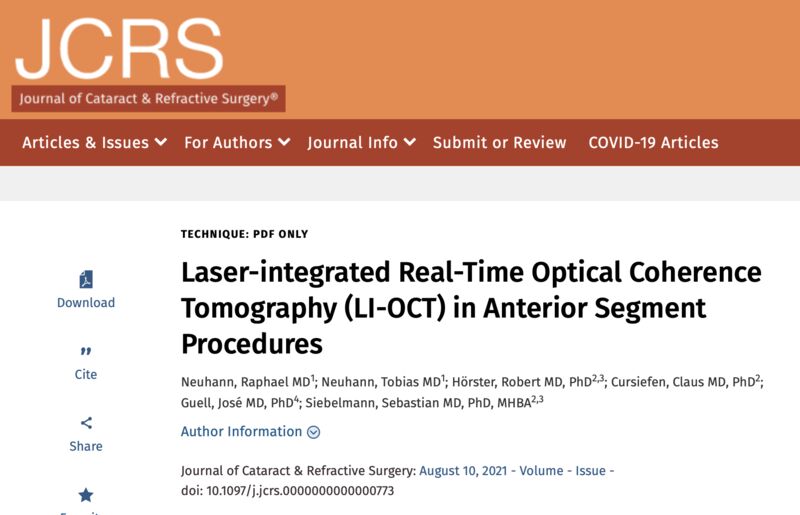Intraoperative optical coherence tomography (OCT) was first described in 2005 by Geerling et al. Since then, a large number of studies have been published highlighting the advantages of this technology.
However, until now, this technology was only available as microscope-integrated OCT (MI-OCT) in addition to the original hand-held OCT (HH-OCT).
Although individual studies have been previously published describing the use of MI-OCT in laser-assisted procedures such as phototherapeutic keratectomy (Siebelmann et al.) as well as manual LASIK, deep anterior lamellar keratoplasty (DALK) (De Benito-Llopis et al.), or penetrating keratoplasty (PKP), direct use in real time during laser application has not been possible due to the design of femtosecond and excimer lasers.
The completely new, fully integrated design of the femtosecond laser "Victus" from Bausch und Lomb (Fig. 1) now makes it possible to display and follow all steps in real time during laser application. Corneal procedures such as LASIK, DALK, PKP as well as ring segment implantation can be monitored directly. This is also possible during femtosecond laser-assisted cataract surgery (femto-phaco).

Figure 1: Femtosecond laser "Victus" from Bausch and Lomb. The scanner of the OCT is built into the laser head in such a way that both femtosecond laser and OCT imaging can be used simultaneously. This enables true laser-integrated OCT imaging (LI-OCT) for the first time and also completely new insights into dynamic processes, especially in femtosecond laser-assisted cataract surgery.
In a recently published study in the Journal of Cataract and Refractive Surgery, first clinical data obtained by LI-OCT during different ophthalmic surgical procedures on both the cornea and the lens could be published in a pilot study.
In the past, intraoperative OCT in surgical procedures has shown on the one hand that individual surgical steps can simply be followed and displayed in real time. On the other hand, completely new insights regarding dynamic processes during surgery could be gained in some operations.
Similar results were obtained with the LI-OCT published by Neuhann et al. All steps of the analyzed corneal surgical procedures like DALK, PKP, LASIK or implantation of intrastromal corneal rings could be visualized and thus monitored.
Furthermore, in femtosecond laser-assisted cataract surgery, not only the individual dissection steps could be followed, but completely new, dynamic processes during surgery were revealed, which were previously unknown.
In this context, for example, a clear forward displacement of the iris-lens diaphragm with increasing amount of gas inside the capsular bag was partly observed. Also, in some cases, a clear, almost explosion-like breakthrough of the gas that had accumulated within the capsular bag or the lens could be seen.
The impact of these processes on intraoperative complications in femtosecond laser-assisted surgery, such as capsular block syndrome (CBS) or intraoperative miosis, is not yet known.
In the future, real-time LI-OCT data could be analyzed automatically using artificial intelligence and integrated into surgical procedures. Algorithms could, for example, follow the individual surgical steps, recognize critical situations and then intervene directly in the surgical procedure, such as creating drainage channels in the anterior chamber in the event of CBS so that a posterior capsule rupture does not occur.
Further links:
Information brochure Bausch and Lomb Victus
More information about the Victus femtosecond laser
References:
Geerling, G., Müller, M., Winter, C., Hoerauf, H., Oelckers, S., Laqua, H., & Birngruber, R. (2005). Intraoperative 2-dimensional optical coherence tomography as a new tool for anterior segment surgery. Archives of Ophthalmology, 123(2), 253-257.
Siebelmann, S., Horstmann, J., Scholz, P., Bachmann, B., Matthaei, M., Hermann, M., & Cursiefen, C. (2018). Intraoperative changes in corneal structure during excimer laser phototherapeutic keratectomy (PTK) assessed by intraoperative optical coherence tomography. Graefe's Archive for Clinical and Experimental Ophthalmology, 256(3), 575-581.
De Benito-Llopis, L., Mehta, J. S., Angunawela, R. I., Ang, M., & Tan, D. T. (2014). Intraoperative anterior segment optical coherence tomography: a novel assessment tool during deep anterior lamellar keratoplasty. American journal of ophthalmology, 157(2), 334-341.



